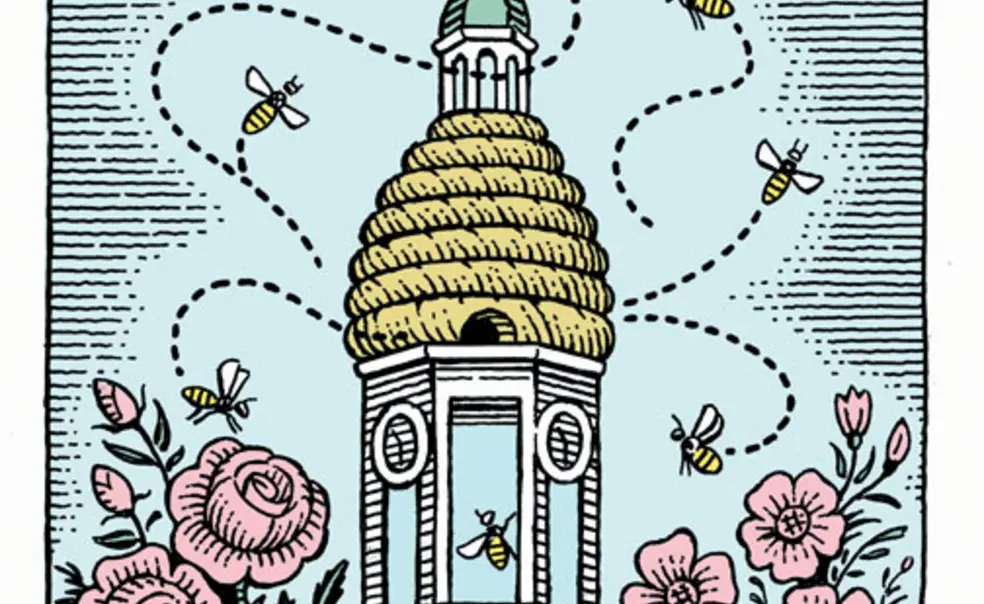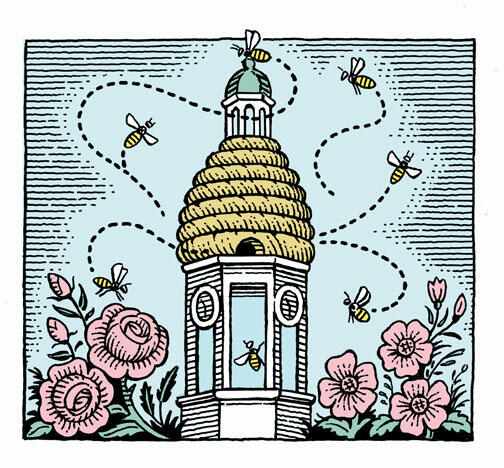Bee Team creates buzz; a decade of dialogue
When a dozen members of the Princeton Bee Team arrived at the club’s apiary near the West Windsor fields off Washington Road on a sunny March Saturday, they split into two groups.
One went inside the wooden enclosure to inspect the hive; the other started to paint the fence around the apiary. Protective gear was limited to mesh facemasks. “With your bare hands, you can feel if the bees are happy,” explained Michael Smith ’10, who founded the student club in September.
While Smith has harbored a love for bees since he picked up apiculture at a boarding school in Wales, and Dawn Lavalle GS tended to hives at a women’s monastery before coming to Princeton for her doctorate in classics, few students in the group had kept bees before. “They tell you in college to do something new and different,” said Hannah Safford ’13, a novice. “When else are you going to try beekeeping?”
For those without apiary know-how, the Bee Team sponsored a series of beekeeping classes with New Jersey state apiarist Bob Hughes and visited beehives on a local farm.
At the Princeton site, Smith reminded students of key tips, including blowing smoke on their hands from a metal can called a “smoker” to help keep bees from stinging.
But 20 minutes later, Yujhan Claros ’10 emerged from the beehive to join the painters. “I got stung!” he proclaimed. “I’m happy because now I know I’m not allergic.”
The next person to come out of the hive had no stings, only good news. “We found larvae so we know there’s a queen,” Smith announced. It was time to open a bucket of sugar syrup to feed the bees — food would encourage more egg-laying, leading to more beekeeping trips in the future.
It’s the perfect study break, LaValle explained, because “beekeeping is farming for academics. You don’t need that much space or time, and there’s no heavy lifting.”
By Nikki Leon ’11
For the past decade, students in Princeton’s Sustained Dialogue initiative have been studying the power of a good conversation. The group — founded by Teddy Nemeroff ’01 and David Tukey ’02 with support from Hal Saunders ’52 — promotes discussion about issues of identity ranging from race and ethnicity to gender and sexual orientation.
In addition to celebrating its 10-year anniversary, the group hosted about 150 participants from a dozen colleges March 26–27 for the annual Sustained Dialogue Campus Network summit. Saunders, president of the International Institute for Sustained Dialogue, developed the network after witnessing the success of the original Princeton chapter.
Sustained Dialogue members (roughly 120 in all) meet weekly in small groups led by student moderators. Each meeting picks up where the last left off, allowing dialogue to deepen throughout the year. Some groups meet in campus centers — the Women’s Center, International Center, LGBT Center, and Carl Fields Center — and focus on related issues. Other groups gather over dinner in a Princeton dining hall and tackle identity as a more general topic.
The goal, said chapter president Osahon Okundaye ’12, is “to help people navigate social pressures as they seek to define their roles on campus.”
Meetings periodically turn to campus concerns. In December, Princeton Borough police used pepper spray to resolve a fight at a Carl Fields Center dance, and some anonymous online commenters responded to a Daily Princetonian article about the event with racially charged statements. Subsequent Sustained Dialogue discussions led to a more thoughtful approach, said vice president Krystal Valentin ’12: “It was evident that it was having an effect and that they were thinking beyond what they would typically think about these situations.”
This year, Sustained Dialogue has renewed its efforts to attract a wider swath of students. “We were disproportionately attracting independent students, students of color, more liberal students,” moderator and former vice president Paul Nehrig ’10 wrote in an e-mail. “On the other hand, we were often missing students from institutions of social power — eating clubs, the USG, athletic teams.”
But the ethos of the group remains the same. As Saunders put it: “We have a problem? Let’s talk about it.”












No responses yet